
VALLEY FORGE, Pa. — AmerisourceBergen Corp.’s backing, combined with the entrepreneurship of independent pharmacies, has made the company’s Good Neighbor Pharmacy network an exemplar of high-touch service, says senior vice president of community and specialty pharmacy and Good Neighbor Pharmacy president Brian Nightengale.
AmerisourceBergen’s support tools and personnel enhance the inherent ability of independents to customize their businesses to meet community needs, he says. That’s reflected in Good Neighbor Pharmacy ranking “Highest in Customer Satisfaction with Chain Drug Store Pharmacies” in the J.D. Power U.S. Pharmacy Study six times in the past eight years.
“Independents look to us to provide some of the benchmarking and data gathering that they wouldn’t necessarily be able to undertake on their own,” Nightengale says. “We help them think beyond the day-to-day and look to a future where they can grow their businesses.”
AmerisourceBergen’s pharmacy services administrative organization, Elevate Provider Network, helps capture data from stores across the country, while Good Neighbor Pharmacy’s dedicated business coaches and field-based retail merchandisers interact with members locally. “Business coaches will sit down with members and look at their work flow, staffing and the market around them and provide suggestions and a road map of how to be more efficient and more profitable, and where they might want to expand,” Nightengale notes.
AmerisourceBergen’s technology platform includes the Patient Engagement Center, which allows pharmacies to identify patients who are ready for a comprehensive medication review (CMR). The pharmacies can then create an appointment-based model where they’ll have those patients come in for the CMR and then maybe enroll in med sync.

Brian Nightengale
Immunizations and point-of-care testing can also be provided. “It is patient care versus prescription care,” comments Nightengale.
When it comes to the complex medications of specialty pharmacy, he says that AmerisourceBergen is endeavoring to have payers broaden coverage and drug makers broaden distribution. “We firmly believe that community-based care is optimal care and that patients should have access to those products in their communities.”
At the more micro level, the company’s business coaches help Good Neighbor Pharmacy pharmacists mine data to identify specialty therapeutic areas with growth potential. The coaches also have modules to instruct pharmacists about certifications needed to gain access to specialty products. And the coaches help with prescriber outreach. “Oftentimes pharmacists have been fortunate enough to have patients walk in their door, and they haven’t had to do a lot of pharmacy-to-physician marketing,” Nightengale observes. “But certainly the large, national, specialty pharmacies do that. So we help that pharmacist get out of his or her comfort zone, out from behind the counter into the community, meeting with prescribers and creating that relationship.”
Generally, Good Neighbor Pharmacy members are being more integrated into the overall health care system, he notes. That’s especially true when it comes to immunizations, which pharmacists didn’t provide at all a couple of decades ago. Today, with the growing shortage of primary care physicians and the recognition of pharmacists as the most accessible health care providers, immunizations for a host of diseases are standard practice at pharmacies.
Such change is being hastened by collaborative practice agreements and the expanding scope of practice for pharmacists, he adds, saying point-of-care testing will be “the next big growth area.” Increased testing will in turn foster limited prescribing privileges, he says.
Nightengale foresees eventual broad-based integration of pharmacies into the health care ecosystem, citing a growing interest in creating enhanced pharmacy services networks. Much is occurring in that regard, especially with chronic care patients, he points out. The idea is “to create a mechanism where a community-based pharmacist is intimately integrated into the ecosystem of caring for that patient, and that patient is enrolled and assigned to that pharmacy, and that pharmacy is connected to the prescriber and the system and the payer. They can then coordinate care — with the goal of the pharmacist playing a big role in reducing unwanted outcomes such as hospitalizations and readmissions.”
From the business perspective, pharmacies can be compensated for these services as medical benefits in addition to getting traditional pharmaceutical benefit payments, he says. “When we’re able to do that, pharmacists can be much more involved in at-risk contracting, because there’s a direct connection between those services and outcomes. That’s where you get value-based reimbursement.” The change is not dependent on government regulation, he adds, but could be expedited by it.
Change, he notes, is coming so fast that independents will need the backing of companies like AmerisourceBergen to remain viable.
While e-commerce is all the rage, he emphasizes that when people are sick, they want to talk to somebody, and they don’t want to wait a day or even a few hours. They want immediate access to personalized care. Community pharmacy is the best place for that, and independents have the time to provide the attentive care that a pharmacy filling 2,000 scripts a day cannot, he says.
The future of community pharmacy, he believes, will be significantly different — and better. “There will be specific roles for pharmacists in the communities that they serve, and sometimes they won’t have to be in the same location. Certainly the more that we can prove our value in the health care ecosystem and the more we can participate more holistically in terms of medical benefits, I can see a future where — beyond remuneration for dispensing —there’s reimbursement for care and outcomes.
“If we can get there, then the health of community pharmacy as a whole will be very strong. And when that happens, I’m convinced that the health of communities that pharmacies serve will also improve. There’s a potential out there for a lot of excitement if we can just get out of our traditional way of thinking.”







